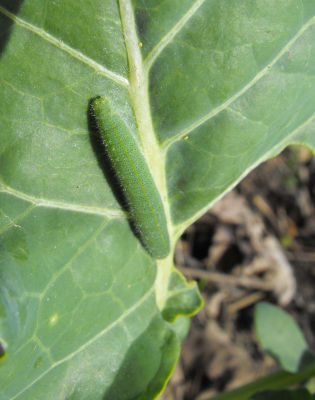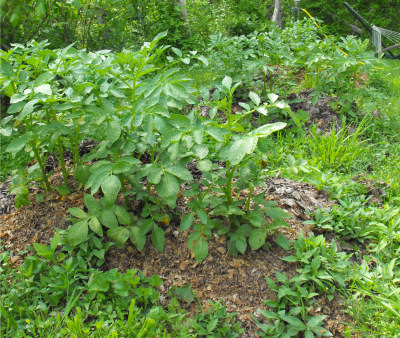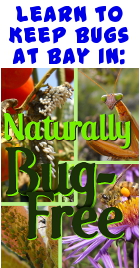
Bad bugs
 In
the last couple of weeks, "bad bugs" have started to show up in the
garden. This guy is a "cabbage worm" (aka Cabbage White
caterpillar) and it enjoys gobbling big bites out of our broccoli and
cabbage plants.
In
the last couple of weeks, "bad bugs" have started to show up in the
garden. This guy is a "cabbage worm" (aka Cabbage White
caterpillar) and it enjoys gobbling big bites out of our broccoli and
cabbage plants.
My approach to cabbage
worm control is pretty lackluster, but it seems to work --- I handpick
the caterpillars whenever I happen to notice them, then feed them to
the chickens. If you're going to head out to check your plants,
look for the dark pellets of frass (poop) on leaves, then lean in
closer and hunt down the caterpillar who left the traces behind.
Cabbage worms like to orient their bodies parallel to veins, making
them difficult to find without the tell-tale frass.
 I
spend even less time worrying about flea
beetles. Tiny
black specks hopping around on the potatoes alerted me to their
presence last week and a close look showed that the potato leaves are
now perforated with hundreds of tiny holes. But the plants don't
seem to mind, so I'm ignoring the flea beetles.
I
spend even less time worrying about flea
beetles. Tiny
black specks hopping around on the potatoes alerted me to their
presence last week and a close look showed that the potato leaves are
now perforated with hundreds of tiny holes. But the plants don't
seem to mind, so I'm ignoring the flea beetles.
I don't mean to suggest
that all "bad bugs" are harmless or easy to deal with. I'm still picking
asparagus beetles
every week, hoping to put a dent in their population and save our
fronds, and I know that we'll be battling squash vine borers all
summer. But I hope that you'll consider a more laissez-faire
approach to bad bugs, at least until they prove themselves a major
hindrance to your garden.
Want more in-depth information? Browse through our books.
Or explore more posts by date or by subject.
About us: Anna Hess and Mark Hamilton spent over a decade living self-sufficiently in the mountains of Virginia before moving north to start over from scratch in the foothills of Ohio. They've experimented with permaculture, no-till gardening, trailersteading, home-based microbusinesses and much more, writing about their adventures in both blogs and books.
Want to be notified when new comments are posted on this page? Click on the RSS button after you add a comment to subscribe to the comment feed, or simply check the box beside "email replies to me" while writing your comment.


One idea to control non-flying bugs is to put a border made out of planks around your vegetable beds. Make sure that the planks connect at the edges, and are firmly embedded in the ground, so it isn't easy to crawl under them.
Now for the crucial bit; line the outside and top of the planks with teflon foil. Tack it to the planks low down (in or near the soil) and over the top on the other side. This stuff is so slippery that even a gecko won't stick to it. Bugs won't be able to climb over it.
Of course this is only a partial solution; it won't deter flying bugs, nor bugs that drop down from overhanging other plants.
Vester, I've read various things about diatomaceous earth, but only in passing. I think some people may use it for flea beetles, but I'm not sure what else.
Lindsey --- yup, squash vine borerers are devastating!!! We're still working out how to deal with them, but this is what we've come up with so far:
Spray with Bt once a week and after every rain. This is a lot of work with even a few large squash plants, and I don't know how much good it actually does, and Bt is organic and supposedly non-harmful to anything except caterpillars but I still don't like it. We do it anyway, because it's the best we've come up with.
Plant resistant varieties. Butternut seems to plug along pretty well even with a mild vine borer infestation since it has tough, semi-solid stems. I just read that Yellow Crookneck squash may be somewhat resistant --- next year, we'll be trying some of that!
Last year, we had good luck giving up on our main crop of summer squash and planting new ones at the beginning of August. This gave us one big flush of squash before the frost, which was much appreciated. Possibly we could have planted a bit earlier, but I don't know how early. Some places say you're safe to plant after the fourth of July, but that would, of course, depend on what part of the country you live in.
If you come up with any other control techniques, please let us know! Squash vine borers and asparagus beetles are currently my archnemesis!
According to the wikipedia article on squash vine borers, wrapping the stem with nylon stockings or aluminum foil helps.